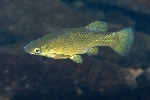Reproductive biology of three native livebearer fish species (Actinopterygii: Cyprinodontiformes: Goodeidae) in the Teuchitlán River, Mexico
作者 Ramírez-García, Arely, Kyle Piller, Juan Pablo Ramírez-Herrejón, Martina Medina-Nava, Rubén Hernández-Morales, Omar Domínguez-Domínguez
Acta Ichthyologica Et Piscatoria, 50(1):1-12 3月-2020. DOI: 10.3750/AIEP/02513
" Background. The Ameca River basin in central Mexico, especially the Teuchitlán River, hosts a rich native and endemic ichthyofauna. The biological traits of these species, however, have not been fully studied, and their habitat has been altered by anthropogenic activities. The aim of this study was to evaluate the reproductive cycle of three native goodeids, and to describe the variation in the reproduction of each species. The results of this study have important conservation implications and can be used to support specific conservation actions, trying to protect specific areas where native species are reproducing, aimed at maintaining biological diversity in the Teuchitlán River.
Materials and methods. This two-year study investigated the fertility, size at first maturity (L 50), sex ratio, gonad maturity stage, and gonadosomatic index of three native livebearer fish species, Goodea atripinnis Jordan, 1880; Ameca splendens Miller et Fitzsimons, 1971; and Zoogoneticus purhepechus Domínguez-Domínguez, Pérez-Rodríguez et Doadrio, 2008. Environmental variables were evaluated, with respect to the reproductive variables, using non-metric multidimensional scaling (NMDS) analysis.
Results. Three hundred and eighty-three specimens of G. atripinnis, 319 of A. splendens, and 170 of Z. purhepechus were examined. Goodea atripinnis was widely distributed along the river, presenting a complete size structure. The endemic species (A. splendens and Z. purhepechus) showed lower abundance downstream. The native species presented two reproductive periods: January through March and July through September. The sex ratio is 1 ÷ 1 (female ÷ male) and the fertility was lower compared to other species in other river basins. The NMDS analysis showed that the native species are associated with clean, deeper waters that present higher dissolved oxygen and a neutral pH.
Conclusion. The lower population abundance of native species downstream in the river is due to the fact that the goodeid species are less tolerant to pollution and cannot reproduce successfully in polluted water. These species have to adapt to the anthropogenic activities that have modified the river, affecting their habitat. In spite of this perturbation, there are no specific conservation actions underway to maintain biological diversity in the Teuchitlán River "
類別: 生理和疾病.
語言: English
在參考書目中的物種引用文獻 (3)
Ramírez-García, Arely & Kyle Piller, Juan Pablo Ramírez-Herrejón, Martina Medina-Nava, Rubén Hernández-Morales, Omar Domínguez-Domínguez. 2020. "Reproductive biology of three native livebearer fish species (Actinopterygii: Cyprinodontiformes: Goodeidae) in the Teuchitlán River, Mexico". Acta Ichthyologica Et Piscatoria. 50(1):1-12. DOI: 10.3750/AIEP/02513 (ffm00967) (摘要)


